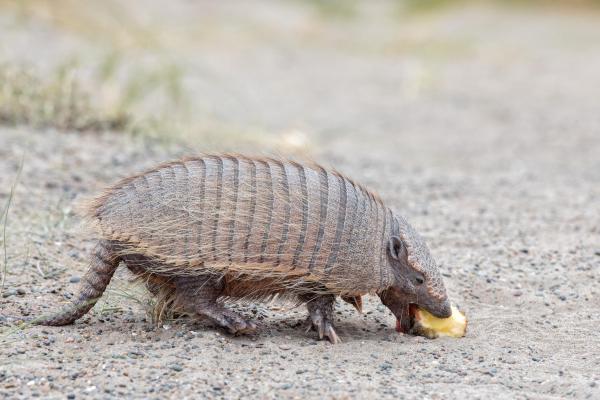What Do Armadillos Eat?


Armadillos, instantly recognizable by their unique armored shells, are fascinating mammals native to the Americas. These diligent diggers and nocturnal foragers play an important role in their ecosystems, contributing to soil health and seed dispersal. Despite their familiarity, many aspects of armadillo biology remain shrouded in mystery, including their diverse and adaptable dietary habits.
The following AnimalWised article explores what armadillos eat, their unique dietary habits and how they find their food.
How is the diet of the armadillo?
Armadillos, known for their armored shells, are members of the Dasypodidae family, which includes 21 species of armadillos distributed across the Americas.
They are extremely adaptable mammals that inhabit a wide range of environments, including tropical rainforests and arid deserts. Given their diverse habitats, it's understandable that their diet is equally varied. In fact, this opportunism is a key factor in their ecological success across the Americas.
Armadillos have evolved to be opportunistic feeders, taking advantage of whatever food sources are available in their environment. This broad range of food items ensures that armadillos can adapt to fluctuations in food availability and environmental conditions.
In fact, while not every armadillo species actively seeks carrion, most, if not all, armadillo species will opportunistically eat carrion if they encounter it. This means that while their primary diet might consist of insects, invertebrates, fruits, or other specific prey, they won't turn down an easy meal like carrion if it's available.
What do baby armadillos eat?
Like all mammals, baby armadillos initially depend entirely on their mother's milk, which provides essential nutrients for their growth and development.
Typically, they nurse for about 2 to 4 months. During nursing, the young armadillos observe their mother's foraging behaviors and learn how to locate and capture insects, facilitating a smooth transition to a solid diet. As they nurse, their digestive systems continue to develop, becoming better equipped to handle the variety of foods adult armadillos consume.
The nursing period varies by especies. Some species, such as the nine-banded armadillo (Dasypus novemcinctus), are relatively precocious at birth. They quickly open their eyes and begin exploring outside the burrow to consume soft insects. Conversely, species like the giant armadillo (Priodontes maximus) are born blind and completely rely on their mother's milk for a longer period, usually around 4-6 months, before transitioning to solid food.
What foods does the adult armadillo eat?
As mentioned earlier, armadillos are omnivores, boasting a diverse diet that caters to their opportunistic foraging strategy. While individual preferences may exist among different species, these choices are heavily influenced by the food availability within their specific habitats.
Solitary feeders by nature, adult armadillos typically forage alone. However, during the mating season, newly formed pairs might be observed feeding together, potentially strengthening their bond.
To truly appreciate the remarkable breadth of their dietary choices, let's explore the specific food preferences of various armadillo species:
- Greater fairy armadillo (Calyptophractus retusus): feeds on insects, larvae, worms, snails, eggs, vegetation, seeds, tubers, and fruits.
- Hairy armadillo (Chaetophractus villosus): feeds on insects, rodents, lizards, carrion, worms, larvae, and vegetation.
- Lesser pichiciego (Chalmyphorus truncatus): mainly feeds on ants and plants.
- Pygmy armadillo (Zaedyus pichiy): feeds on insects, worms, lizards, rodents, plant matter, and carrion.
- Giant armadillo (Priodontes maximus): primarily feeds on termites and ants, but also consumes worms, reptiles, and carrion.
- Southern naked-tailed armadillo (Cabassous unicinctus): mainly feeds on termites and ants, along with other invertebrates.
- Andean hairy armadillo (Chaetophractus vellerosus): feeds mainly on beetles and also consumes vegetable matter.
- Northern naked-tailed armadillo (Cabassous centralis): has a varied diet including larvae, beetles, termites, ants, worms, bird eggs, reptiles, and amphibians.
- Six-banded armadillo (Euphractus sexcinctus): primarily consumes plant matter such as fruits, tubers, and nuts, along with termites, ants, frogs, and carrion.
- Southern long-nosed armadillo (Dasypus hybridus): feeds on crickets, beetles, termites, spiders, amphibians, reptiles, leaves, and fruits.
Dive deeper into the world of armadillos with our guide to different species in this article.
How much does the armadillo eat?
Although the exact amount of food that an armadillo eats is unknown, they only have a small window of time each day to forage due to their 16-hour sleep cycle.
To make the most of their time, armadillos often choose to build their burrows strategically close to food sources. For species that enjoy feasting on termites and ants, finding a nest is like hitting the jackpot. Their strong claws act like can openers, allowing quick access to the insect feast, while their sticky tongues make sure nothing goes to waste.
Interestingly, armadillos rely mainly on their sharp sense of smell and keen hearing to find food, rather than sight or taste. Their impressive claws make them skilled diggers, helping them uncover hidden treats buried underground. These unique feeding behaviors play a crucial role in the armadillo's survival, showcasing their remarkable adaptations to their environment.
Considering an armadillo as a pet? Learn everything you need to know in this guide.
If you want to read similar articles to What Do Armadillos Eat?, we recommend you visit our Healthy diets category.
- Animal Diversity Web. (2020). Available at: https://animaldiversity.org/
- ITIS (2022). Dasypodidae . Available at: https://www.itis.gov/servlet/SingleRpt/SingleRpt?search_topic=TSN&search_value=180101#null





